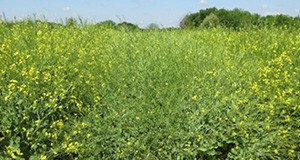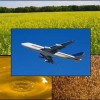
Carinata has been grown commercially for several years on the Canadian prairie and more recently in the US northern plains as a summer crop. For the past four years, UF has been conducting research to evaluate various management practices that allow incorporation of carinata into current cropping systems as a winter crop with minimal modification to existing infrastructure in the southeastern US. This 8-page fact sheet is a major revision that discusses carinata characteristics, biology, nutrient management, tillage, variety selection, planting dates, seeding depth, seeding rate, row spacing, weed management, disease management, insect management, harvest management, economics, and crop insurance. Written by Ramdeo Seepaul, Christine M. Bliss, David L. Wright, Jim J. Marois, Ramon G. Leon, Nicholas Dufault, Sheeja George, and Steve M. Olson, and published by the UF Agronomy Department, December 2014. Revised October 2015.
http://edis.ifas.ufl.edu/ag389
Tag: Energy Crops
Carinata Production in Florida
 Brassica carinata is a promising oilseed crop with great potential for profitable cultivation in Florida. Its high oil content and favorable fatty acid profile make it suitable for the biofuel industry, especially as a biojet fuel. The UF/IFAS North Florida Research and Education Center (NFREC) in Quincy, Florida, has been working to identify advanced carinata genotypes that are high yielding (seed and oil), disease resistant, early maturing, and adapted to Florida. The work at NFREC is being done in conjunction with Agrisoma Biosciences Inc., a crop company that has the world’s largest collection of carinata germplasm. This 6-page fact sheet’s “Agronomic Management” section provides recommendations resulting from NFREC’s research. was written by C. M. Bliss, R. Seepaul, D. L. Wright, J. J. Marois, R. Leon, N. Dufault, S. George, and S. M. Olson, and published by the UF Department of Agronomy, December 2014.
Brassica carinata is a promising oilseed crop with great potential for profitable cultivation in Florida. Its high oil content and favorable fatty acid profile make it suitable for the biofuel industry, especially as a biojet fuel. The UF/IFAS North Florida Research and Education Center (NFREC) in Quincy, Florida, has been working to identify advanced carinata genotypes that are high yielding (seed and oil), disease resistant, early maturing, and adapted to Florida. The work at NFREC is being done in conjunction with Agrisoma Biosciences Inc., a crop company that has the world’s largest collection of carinata germplasm. This 6-page fact sheet’s “Agronomic Management” section provides recommendations resulting from NFREC’s research. was written by C. M. Bliss, R. Seepaul, D. L. Wright, J. J. Marois, R. Leon, N. Dufault, S. George, and S. M. Olson, and published by the UF Department of Agronomy, December 2014.
http://edis.ifas.ufl.edu/ag389
Economic Potential of Switchgrass as a Biofuel Crop in Florida (FE900)
 Switchgrass has been recognized by the United States Department of Energy as a potentially important source of ethanol. This publication evaluates the economic potential of producing switchgrass as a perennial bioenergy crop in Florida. In South Florida, two cuts of “hay” for biofuel are possible, whereas in North Florida, one cut would normally be taken after frost in late fall. These two harvest systems are evaluated and compared, and cost estimates are provided. This 7-page fact sheet was written by Zane R. Helsel and José Álvarez, and published by the UF Department of Food and Resource Economics, December 2011.
Switchgrass has been recognized by the United States Department of Energy as a potentially important source of ethanol. This publication evaluates the economic potential of producing switchgrass as a perennial bioenergy crop in Florida. In South Florida, two cuts of “hay” for biofuel are possible, whereas in North Florida, one cut would normally be taken after frost in late fall. These two harvest systems are evaluated and compared, and cost estimates are provided. This 7-page fact sheet was written by Zane R. Helsel and José Álvarez, and published by the UF Department of Food and Resource Economics, December 2011.
http://edis.ifas.ufl.edu/fe900
Production of Biofuel Crops in Florida: Sweet Sorghum (SSAGR293/AG298)
 Varieties of sorghum with a high concentration of soluble sugars are attractive as a potential energy crop because of the easy accessibility of readily fermentable sugars combined with very high yields of green biomass. Similar to sugarcane, the sap of sweet sorghum is extracted by milling, and can be easily fermented to produce ethanol. Other products from sweet sorghum include syrup, molasses, and crystal sugar. This 3-page fact sheet was written by Wilfred Vermerris, John Erickson, David Wright, Yoana Newman, and Curtis Rainbolt, and published by the UF Department of Agronomy, December 2011.
Varieties of sorghum with a high concentration of soluble sugars are attractive as a potential energy crop because of the easy accessibility of readily fermentable sugars combined with very high yields of green biomass. Similar to sugarcane, the sap of sweet sorghum is extracted by milling, and can be easily fermented to produce ethanol. Other products from sweet sorghum include syrup, molasses, and crystal sugar. This 3-page fact sheet was written by Wilfred Vermerris, John Erickson, David Wright, Yoana Newman, and Curtis Rainbolt, and published by the UF Department of Agronomy, December 2011.
http://edis.ifas.ufl.edu/ag298
Jatropha: An Alternative Substitute to Fossil Fuel (HS1193)
 Jatropha is a tropical plant and can be grown in low to high rainfall and diverse soil types, but the plant is susceptible to freezes. The plant produces seeds containing inedible oil that can be converted to biodiesel. The cake by-product from oil extraction can be used for fish and animal feed, biogas, or as an organic fertilizer. This 10-page fact sheet describes the plant morphology, species adaptability, cultural practices, and crop uses. Written by Kamrun Nahar and Monica Ozores-Hampton, and published by the UF Department of Horticultural Sciences, December 2011. (UF/IFAS Photo by Tyler Jones)
Jatropha is a tropical plant and can be grown in low to high rainfall and diverse soil types, but the plant is susceptible to freezes. The plant produces seeds containing inedible oil that can be converted to biodiesel. The cake by-product from oil extraction can be used for fish and animal feed, biogas, or as an organic fertilizer. This 10-page fact sheet describes the plant morphology, species adaptability, cultural practices, and crop uses. Written by Kamrun Nahar and Monica Ozores-Hampton, and published by the UF Department of Horticultural Sciences, December 2011. (UF/IFAS Photo by Tyler Jones)
http://edis.ifas.ufl.edu/hs1193
Production of Giant Reed for Biofuel (SSAGR318/AG327)
 Giant reed is currently being evaluated as a potential biomass energy crop in Florida, even though some scientists and those in other states consider it to be a noxious or invasive weed. This 4-page fact sheet discusses the adaptation and production of giant reed as a potential energy crop and presents measures for controlling giant reed as an escaped weed. It does not give specific recommendations on whether it is better to control giant reed or produce it for biofuel. Written by Dennis Odero, Robert Gilbert, Jason Ferrell, and Zane Helsel, and published by the UF Department of Agronomy, November 2011.
Giant reed is currently being evaluated as a potential biomass energy crop in Florida, even though some scientists and those in other states consider it to be a noxious or invasive weed. This 4-page fact sheet discusses the adaptation and production of giant reed as a potential energy crop and presents measures for controlling giant reed as an escaped weed. It does not give specific recommendations on whether it is better to control giant reed or produce it for biofuel. Written by Dennis Odero, Robert Gilbert, Jason Ferrell, and Zane Helsel, and published by the UF Department of Agronomy, November 2011.
http://edis.ifas.ufl.edu/ag327
Economic Feasibility of Biofuel Crops in Florida: Sugarcane on Mineral Soils (SC090)
 This 9-page fact sheet provides estimates of costs and returns to produce ethanol from sugarcane, rather than sugar. These preliminary estimates should guide researchers as to whether sugarcane varieties are economically feasible to be considered for biofuel/energy production. Written by José Álvarez and Zane R. Helsel and published by the UF Department of Food and Resource Economics, August 2011. UF/IFAS Photo by Tom Wright.
This 9-page fact sheet provides estimates of costs and returns to produce ethanol from sugarcane, rather than sugar. These preliminary estimates should guide researchers as to whether sugarcane varieties are economically feasible to be considered for biofuel/energy production. Written by José Álvarez and Zane R. Helsel and published by the UF Department of Food and Resource Economics, August 2011. UF/IFAS Photo by Tom Wright.
http://edis.ifas.ufl.edu/sc090
Economic Feasibility of Biofuel Crops in Florida: Energycane on Mineral Soils (SC089)
 Energycane is a cross of commercial sugarcane with wild sugarcane. It is higher in fiber and lower in sucrose than commercial sugarcane. This 7-page fact sheet provides estimates of costs and returns to sugarcane farmers and determines whether energycane can provide sufficient economic returns to warrant further research into its use as an energy crop. Written by José Álvarez and Zane R. Helsel and published by the UF Department of Food and Resource Economics, August 2011. USDA/ARS photo by David Nance.
Energycane is a cross of commercial sugarcane with wild sugarcane. It is higher in fiber and lower in sucrose than commercial sugarcane. This 7-page fact sheet provides estimates of costs and returns to sugarcane farmers and determines whether energycane can provide sufficient economic returns to warrant further research into its use as an energy crop. Written by José Álvarez and Zane R. Helsel and published by the UF Department of Food and Resource Economics, August 2011. USDA/ARS photo by David Nance.
http://edis.ifas.ufl.edu/sc089
Economic Potential of Sweet Sorghum for Ethanol Production in South Florida (FE896)
 Sweet sorghum has been designated as “potentially viable” as a biofuel crop. This 8-page fact sheet evaluates the economic potential of producing sweet sorghum as an annual bioenergy crop in the state of Florida. Written by Zane R. Helsel and José Álvarez, and published by the UF Department of Food and Resource Economics, August 2011. UF/IFAS cover photo: Tyler Jones.
Sweet sorghum has been designated as “potentially viable” as a biofuel crop. This 8-page fact sheet evaluates the economic potential of producing sweet sorghum as an annual bioenergy crop in the state of Florida. Written by Zane R. Helsel and José Álvarez, and published by the UF Department of Food and Resource Economics, August 2011. UF/IFAS cover photo: Tyler Jones.
http://edis.ifas.ufl.edu/fe896
Eucalyptus and Corymbia Species for Pulpwood, Mulchwood, Energywood, Windbreaks, and/or Phytoremediation (CIR1194/FR013)
In Florida, Eucalyptus species grow faster than our native tree species. Certain species, when planted on suitable sites and managed properly, can produce commercial products such as pulpwood, mulchwood, and energywood, can remediate environmental problems, or may be used as windbreaks for citrus and vegetables. This circular describes potential applications and presents planting guidelines for these three species. This revised 7-page fact sheet was written by D. L. Rockwood and G. F. Peter, and published by the UF Department of School of Forest Resources and Conservation, March 2011.
http://edis.ifas.ufl.edu/fr013
Camelina Production in Florida (SSAGR340/AG350)
Camelina (Camelina sativa (L)) is an old-world crop used primarily for oil. It can be grown under semi-arid conditions. Breeding efforts have resulted in very few improvements. It is a member of the Brassicaceae or mustard family and related to canola and cole crops. The seed is about 35% oil, and the oil is high in omega-3 fatty acid, which has been cited as having health benefits. Camelina meal can be fed to livestock, producing eggs and meat that are higher in omega-3 fatty acids. Interest in camelina is not only due to its high level of omega-3 fatty acids but because it is a renewable source of feedstock for biodiesel and advanced biofuels.
This 3-page fact sheet was written by David Wright and Jim Marois, and published by the UF Department of Agronomy, February 2011.
http://edis.ifas.ufl.edu/ag350
SSAGR329/AG339 Permit Requirements for Planting Non-native Energy/Biomass Crops in Florida
SSAGR329, a 4-page fact sheet by Ken Langeland, discusses why plantings of nonnative plants are regulated, describes how plantings are regulated in Florida, and shows how IFAS determines if nonnative plants are invasive in Florida. Includes references. Published by the UF Department of Agronomy, March 2010.
http://edis.ifas.ufl.edu/ag339